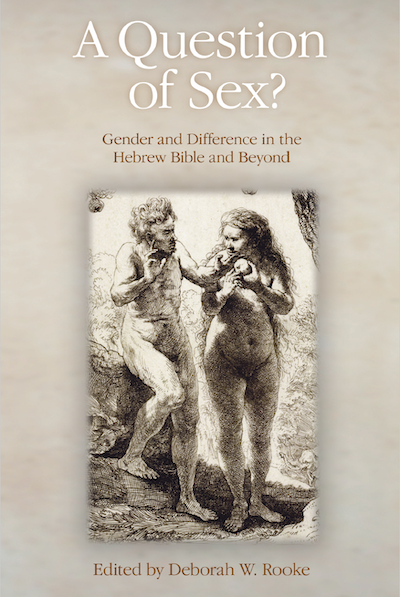A Question of Sex? Gender and Difference in the Hebrew Bible and Beyond
Published: Dec 2009
Price range: £17.50 through £45.00
Gender differences between men and women are not just a matter of sexual differentiation; the roles that men and women play are also socially and culturally determined, in ancient Israel and post-biblical Judaism as in every other context.
That is the theme of these ten studies. The first part of the volume examines the gender definitions and roles that can be identified in the Hebrew Bible's legal and ritual texts. The second part uses archaeological and anthropological perspectives to interrogate the biblical text and the society that formed it on issues of gender. The third part explores similar gender issues in a range of material outside the Hebrew Bible, from the Apocrypha through Josephus and Philo down to mediaeval Jewish marriage contracts (ketubbot).
Among the questions here discussed are: Why are men, but not women, required to bathe in order to achieve ritual purity after incurring certain types of defilement? What understandings of masculinity and femininity underlie the regulations about incest? Was ancient Israel simply a patriarchal society, or were there more complex dynamics of power in which women as well as men were involved? What do post-biblical re-interpretations of the female figures of Wisdom and Folly in Proverbs 1 —9 suggest about heterosexual masculinity? And what kind of rights did mediaeval Middle-Eastern Jewish women have within their marriage relationships?
This is the first volume in the sub-series King's College London Studies in the Bible and Gender. The second is Embroidered Garments: Priests and Gender in Biblical Israel (2009).
A Question of Sex? Gender and Difference in the Hebrew Bible and Beyond
Price range: £17.50 through £45.00
Gender differences between men and women are not just a matter of sexual differentiation; the roles that men and women play are also socially and culturally determined, in ancient Israel and post-biblical Judaism as in every other context.
That is the theme of these ten studies. The first part of the volume examines the gender definitions and roles that can be identified in the Hebrew Bible's legal and ritual texts. The second part uses archaeological and anthropological perspectives to interrogate the biblical text and the society that formed it on issues of gender. The third part explores similar gender issues in a range of material outside the Hebrew Bible, from the Apocrypha through Josephus and Philo down to mediaeval Jewish marriage contracts (ketubbot).
Among the questions here discussed are: Why are men, but not women, required to bathe in order to achieve ritual purity after incurring certain types of defilement? What understandings of masculinity and femininity underlie the regulations about incest? Was ancient Israel simply a patriarchal society, or were there more complex dynamics of power in which women as well as men were involved? What do post-biblical re-interpretations of the female figures of Wisdom and Folly in Proverbs 1 —9 suggest about heterosexual masculinity? And what kind of rights did mediaeval Middle-Eastern Jewish women have within their marriage relationships?
This is the first volume in the sub-series King's College London Studies in the Bible and Gender. The second is Embroidered Garments: Priests and Gender in Biblical Israel (2009).
Recent Research on the Major Prophets
Published: Oct 2008
£60.00
Given the many new methods and approaches for interpreting biblical literature that have appeared in the past several decades, it is hardly surprising that our understanding of the prophets Isaiah, Jeremiah and Ezekiel has expanded and diversified at a rapid pace. Historical-critical understandings and perspectives have been challenged and often dramatically altered. New approaches, such as social-scientific criticism, rhetorical criticism, feminist criticism, reader response criticism, literary analysis, anthropological analysis, structuralist criticism, ideological criticism, and deconstructionist criticism have both challenged old approaches and shed new light on the texts being studied.
In this volume, Alan Hauser presents eleven articles, each with an extensive bibliography, that survey the variety and depth of recent and contemporary scholarship on these three prophets. Five of them are new to this volume. All are written by experts in each area of scholarship, including Marvin Sweeney, Paul Kim, Roy Melugin, Robert P. Carroll, Peter Diamond, Katheryn Pfisterer Darr and Risa Levitt Kohn. Hauser introduces the volume with a comprehensive summary and overview of the articles.
Recent Research on the Major Prophets
£60.00
Given the many new methods and approaches for interpreting biblical literature that have appeared in the past several decades, it is hardly surprising that our understanding of the prophets Isaiah, Jeremiah and Ezekiel has expanded and diversified at a rapid pace. Historical-critical understandings and perspectives have been challenged and often dramatically altered. New approaches, such as social-scientific criticism, rhetorical criticism, feminist criticism, reader response criticism, literary analysis, anthropological analysis, structuralist criticism, ideological criticism, and deconstructionist criticism have both challenged old approaches and shed new light on the texts being studied.
In this volume, Alan Hauser presents eleven articles, each with an extensive bibliography, that survey the variety and depth of recent and contemporary scholarship on these three prophets. Five of them are new to this volume. All are written by experts in each area of scholarship, including Marvin Sweeney, Paul Kim, Roy Melugin, Robert P. Carroll, Peter Diamond, Katheryn Pfisterer Darr and Risa Levitt Kohn. Hauser introduces the volume with a comprehensive summary and overview of the articles.



